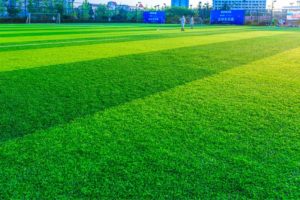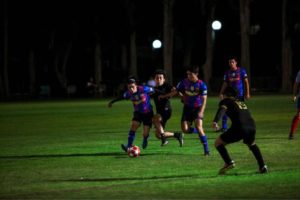The introduction of new hybrid turf has increased the use of turf in playing fields.
The rising prevalence of turf in soccer has led to an escalating concern about the potential negative effects on knee health.
As a result, many are now questioning whether playing soccer on turf harms the knees.

The report of Transparency Market Research witnesses the shift from traditional grass grounds to turf.
It reveals that the 2.6 billion USD valued global turf market will reach 5.8 billion USD by the end of 2027.
Though turf offers many benefits, there are serious concerns about knee injuries while playing soccer on turf.
Thus with increased demand, concerns about potential health issues are also increasing.
The article will briefly explain the impact of turf on knees while playing soccer. We will also discuss some necessary precautions that can help you reduce the damages.
What is Turf?
Turf, also known as artificial grass and synthetic turf, is a playing surface. It is made up of synthetic fibers and gives a more aesthetic and natural grass-like look.
However, unlike natural grass, the method for installing turf is different.
It is done by maintaining a base of sand and crushed rocks and then applying rubber pallets on top.
Turf demand is increasing due to the various benefits it offers.
It requires low maintenance, can withstand heavy use, and can be used in various weather conditions.
However, there are increased concerns about potential health risks, increased injury chances, and athletic performance.
Is Soccer on Turf Bad for Knees?
Playing on turf comes with both advantages and disadvantages.
Though Turf provides speed, consistency, and safety, it is also associated with various physical injuries.
Among all the physical injuries, knee injuries are most common among soccer players across the globe.
It could be the anterior cruciate ligament (ACL) or the posterior cruciate ligament (PCL). They occur when a player turns, stops, twists, or lands awkwardly on their knee.
Studies Associated with Knee Injuries on Turf
Multiple studies have analyzed the chances of knee injuries between players on grass and turf. Below are some:
1. The study by National Football League
A 2019 study by the National Football League revealed the risks associated with a turf field. Some important findings of the study include:
- Non-contact lower body injuries were 27% more on synthetic turf.
- On turf, there were 56% more chances of missing time due to ankle, foot, or knee injuries.
- 4% of NFL players believe that playing on turf leads to more injuries.
2. The study by The American Journal of Sports Medicine
The study reveals that playing on artificial grass can increase the risk of anterior cruciate ligament (ACL).

The study also states that males playing on turf are more prone to knee injury.
3. The study by the National Institute of Arthritis and Musculoskeletal and Skin Diseases (NIAMS)
This study in NIAMS states that the chances of knee injuries increase on turf due to harder surfaces.
These surface puts more pressure on joints, eventually leading to ligament and meniscus injuries.
Although the above-given studies suggest that playing on turf increases the risks of knee injuries.
But it is also important to note that there are some studies that have not found any significant difference between playing on turf or natural grass.
Such a study by The American Journal of Sports Medicine concludes that in some cases playing on turf can be much safer than playing on grass. Thus some other factors also contribute to a knee injury while playing on turf. These include:
- Type and quality of turf being used.
- Player’s shoe quality and type.
- The intensity of the game.
- Biomechanics and individual characteristics of each player.
Why Playing Soccer on Turf Causes Knee Injuries?
The structure of the knee joint is complex. It is composed of various tendons, ligaments, bones, and cartilage.
Its structure is designed to provide stability while allowing movement in various directions.
However, its complex nature and stresses during the game make it more prone to injuries.
There are many factors that contribute to the knee injury while playing soccer on turf. Some of them are explained below:
Hardness of Turf
Most of the low-grade turfs are composed of hard surfaces like recycled tires. Thus they have less cushion, harder and less forgiving.
Ultimately when any knee joint lands on such a surface, the pressure on the joint is increased, eventually leading to injury.
A study in the Journal of Strength and Conditioning Research says that the chances of knee injury on turf composed of hard material are higher than turfs made of synthetic fibers.
Traction and Footwear
Traction is an important factor that contributes to knee injuries on turf. Turfs provide less friction as compared to natural grass. This increases the chances of slipping and injury.
Furthermore, the role of footwear is also vital in injuries on turf. This can be elaborated by the study published in The British Journal of Sports Medicine.
The study reveals that shoes with long cleats have increased risks of knee injury on turf.

Quality and Type of Infill Material
Infill materials are part of turf that provide stability and cushion. They can be of various types like sand, crushed stones, or rubber.
The infill type and depth affect the player’s movement during the game.
Moreover, infills like crumb rubber are also associated with other health risks in athletes like skin irritation and cancer.
Preventing Knee Injuries in Soccer
Despite the complexity of knee joints, some simple precautions can effectively help in reducing the chances of a knee injury while playing soccer on turf.
These precautions are given below:
ACL Injury Prevention Training
This training is specially designed to reduce the chances of ACL injury.
As ACL injury is quite common in soccer players, playing on turf, thus it is highly advised while playing on turf.
The training includes a combination of different exercises that aims to improve balance, agility, and lower limb strength.
The exercises can include step-ups, squats, balance exercises, and lunges.
It is important to note that the training should be supervised by a trained professional or physical therapist.
Proper Warm-up Routines
Warming up your body is effective in reducing the chances of any physical injury by preparing your muscles and joints for physical activity.
For this, slow jogging or other exercises can serve the purpose.
It is worth noting that cooling down your body is also necessary to prevent any chance of injury.
Use of Knee Pads
Knee pads can also effectively reduce the chances of injury. They provide cushion and support for knees, eventually limiting the chances of impact injuries.
The Bottom Line
Playing soccer on turf is associated with knee injuries, especially ACL injuries.
This happens with hard surfaces and traction puts pressure on the knee joint, eventually leading to meniscus and ligament injuries.
However, it’s important to note that not all studies co-relate knee injuries with turf. There are other factors that can also contribute.
Thus to curtail the chances of a knee injury, it is advised to engage in ACL prevention training.
Furthermore, proper warm-up, use of knee pads, and a good diet are also recommended.
Ultimately the playing decision should be based on various factors, which include player preference, field availability, and injury history.

Some people collect expensive old cars, and I’m into collecting bikes. I have 15 different bikes: special mountain bikes, sportbikes, professional, amateur, and city bikes. My friends and colleagues call me a ‘bike expert’ because I give advice on how to choose the right bike.
I’m also a massive fan of gym culture and heavyweight workouts. I met Alan at my local gym, and we’ve become friends quite soon. His idea of starting a sports blog seemed interesting to me, so I agreed to help.





